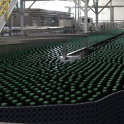|
Super Rad posted:Has anyone used both a Blichmann beer gun and a traditional counterpressure filler? If so can you comment on how well each works? I've got a Blichmann and it works great. I just recently bottled 30 gallons for a wedding with no problems.
|
|
|
|

|
| # ? May 15, 2024 11:41 |
|
Just wrapped up my first AG using BIAB no sparge. What a pain in the rear end. Upping the grain (12.6 lbs) to counteract the lower efficiency completely filled up a 5 gallon paint bag and nearly overflowed my 8 gal kettle. Using whole hops clogged up my auto-siphon, which then broke while cleaning hops out with two gallons left to go. Couldn't find any cheesecloth to cover the nozzle immediately beforehand. BrewSmith is giving me an efficiency of 59%. Time to get a goddamn cooler.
|
|
|
|
Yeah, I spent a while messing around with a crazy partial mash system involving five or six pounds of grain and my oven, but finally gave up and bought the cooler. I had been trying to avoid it, because I didn't want another big piece of equipment to store. But brewing has been so much simpler ever since.
|
|
|
|
Jesus there's a lot of posts I have to work though. My computer's been broke (still is) in addition to some financial difficulties so I haven't been able to brew or talk about it as much as I like. I was checking on my 9 month old Flanders Red last night and found some fruit flies in the airlock. I don't think any got in cause there was enough liquid in there, but in case they did, that won't ruin the batch, right? I know flies have lacto and aceto all over them, but seeing as those bugs are already in the beer and I'm sure the bulk of the fermentation's over with, I feel like I'm safe, but I'd be PISSED if it got hosed up this far in.
|
|
|
|
Not sure, but here's another tale about bugs in home brew:"Washington Heights HBC posted:Early in 1990, Andy Frahm and Roger Glaser decided to brew an adjunct beer and settled on a maple stout. A friend of Andy's, Bill Lanctot, was invited over to satisfy his desire to see how the "pros" did it, as he was interested in picking up this fascinating hobby for himself. The brew, which called for 3 quarts of maple syrup and about eight pounds of malt extract, was tentatively dubbed "Mystic Maple Stout". In retrospect, the beer should have been called "Tragic Maple Stout" as is evidenced by the following reminiscence.
|
|
|
|
j3rkstore posted:I've got a Blichmann and it works great. I just recently bottled 30 gallons for a wedding with no problems. Awesome! Do you know if there's anything unique in either of the accessory kits that I couldn't just piece together at my LHBS for cheaper?
|
|
|
|
Total newb question here: Sorry to ask, but I find its really difficult to find a straightforward answer for the simple stuff on all the sites and forums I've been to so far. There's a hundred different opinions, and people seem more concerned about touting the merits of there regime instead of actually telling you how to do it. :P (sorry, thats not in reference to this thread, but the other resources I've come across) In the next week or so I'll be getting ready to bottle my first homebrew batch from a kit. The kit came with bottles and said that for the first use it was fine to just rinse them with hot water, but I dont want to trust that so I want to do a sanitization run on them. Keep in mind that I'm a guy with limited equipment. I keep hearing about starsan. Would it be sufficient to have the bottles sit for 30 seconds in a vat of starsan and then letting them dry? Also is it even necessary to let them dry? For future batches I want to slowly build up an army of Grolsch bottles and use them. Now when I start doing that, would it be a wise investment (time wise) to invest in a bottle tree, and one of those sanitizer pump things (Sulfatizers? I see them by a hundred names)? And which solution would I use with that? edit: Also, tragic story. My dad had at least 48 Grolsch swing-tops in the cellar for decades. They thought they were moving, so he got rid of them because he hasnt touched them for 20 years. This was about.... oh, 4 months ago. edit 2: Also, when priming for secondary fermentation people keep mentioning transferring it from the fermenter to a bottling bucket. What is the purpose of this? Is it just so you can cut down on the sediment? Les Oeufs fucked around with this message at 17:19 on Mar 22, 2012 |
|
|
|
Les Oeufs posted:Keep in mind that I'm a guy with limited equipment. I keep hearing about starsan. Would it be sufficient to have the bottles sit for 30 seconds in a vat of starsan and then letting them dry? Also is it even necessary to let them dry? Rinse, dip in starsan, let sit for ~30 seconds, dump starsan back into the bucket and bottle. You don't need to let it dry. If you're going to keep bottling then the bottle tree and sanitizer pump are timesavers, but not strictly necessary. You would use starsan with the sanitizer pump. I got mine after bottling a few 5 gallon batches, but haven't used them yet.
|
|
|
|
I have no experience with StarSan, but we really enjoy our bottle tree and tabletop pump sanitizer. If you have help, you don't need anything bigger than the 48-bottle tower: once you get about 30 bottles in, the first ones are dry and you can start filling bottles while the other person keeps rinsing. Ideally you also want a third person to cap bottles and as a float to troubleshoot any issues while you fill (like grabbing another box of bottles or whatever).
|
|
|
|
Starsan is the One True Sanitizer Your instincts are good; I wouldn't use unsanitized bottles either even if they are brand new. You invested a lot of time and money in this batch, why risk ruining it at the very last step? Fill a bucket with Starsan, soak a batch of bottles for a minute, then drain and fill. You don't need to wait for it to dry. As long as you use Starsan at the proper dilution, it's totally harmless and tasteless and actually degrades into a yeast nutrient.
|
|
|
|
Docjowles posted:and actually degrades into a yeast nutrient. No poo poo? That's awesome. I wish more stuff worked that way.
|
|
|
|
I can't find a quote from the manufacturer in very cursory googleing, but I've heard it dozens of times. Google for "starsan foam yeast nutrient" and there's tons of hits, I hope I'm not just perpetuating homebrew urban legend
|
|
|
|
Les Oeufs posted:edit 2: Also, when priming for secondary fermentation people keep mentioning transferring it from the fermenter to a bottling bucket. What is the purpose of this? Is it just so you can cut down on the sediment? It's easier to get the priming sugar mixed into the (flat) beer if you transfer from one bucket to another. Also if you're like me and you only use your spout bucket to fill bottles, then you need to get the beer in there some way. You don't want to stir beer or pour / slosh it around cause you'll mix oxygen back in and that's bad. Also, what happens after bottling isn't secondary fermentation, it is carbonating the beer. 'Secondary Fermentation' is somewhat of a misnomer anyway, since in general you don't want the beer fermenting in secondary. Typically secondary is used for long rests, to 'lager' when using lager yeast, or to add flavors after fermentation (Dry hop, oak, fruit, etc.) You do this to avoid the beer sitting on yeast forever (Which will eventually cause off flavors) and to avoid the yeast interacting with whatever flavorants you are adding.
|
|
|
|
Les Oeufs posted:Sorry to ask, but I find its really difficult to find a straightforward answer for the simple stuff on all the sites and forums I've been to so far. There's a hundred different opinions, and people seem more concerned about touting the merits of there regime instead of actually telling you how to do it. :P (sorry, thats not in reference to this thread, but the other resources I've come across) That's the main reason for my... well, I won't say 'hate,' but distaste anyway, for HBT and other dedicated forums. Over in GBS, there's a discussion about the future of forums, and I think the SA Forums are fairly unique in the level of respect the posters have for each other, and therefore in the high quality of discussion. I also think you're right to sanitize the bottles before using them, even the first time. I won't go quite so far as Doc Jowles in declaring my love for Star-San, but it is awfully drat good. Iodophor is also good, but Star-San is excellent. All you really need to do to sanitize clean bottles is to get the inside of the bottle good and wet with sanitizer solution, let the bottle drain for about 30 seconds, and fill with primed beer. Don't forget to sanitize your caps also. There's no need to let the bottles fully dry or anything. One of those sanitizer fountain-pumps would work great with Star-San or with iodophor. By doing this and by using a spray bottle to sanitize your bottling bucket (instead of filling it with prepared solution), you can dramatically reduce the amount of sanitizer you need to make a batch. The proper dilution of Star-San concentrate is 1 ounce per 5 gallons, 6mL per gallon, or 1.5mL per quart - a pipette or syringe makes measuring it very simple. Yes, the purpose of transferring to a bottling bucket is to reduce sediment. By the end of a ferment, you'll have a good solid layer of gunk in the bottom of the fermenter - gunk that, while not harmful, certainly would reduce the appeal of the beer. And, since the objective is to mix the priming sugar into the beer uniformly, it would be difficult to do so without stirring up all that sediment. I generally recommend boiling the weighed priming sugar with a couple of pints of water, putting it into the bottom of a sanitized bottling bucket, and then racking your beer from the fermenter into the bottling bucket. If you can get the beer to swirl a bit as it racks in, it will mix up all on its own, or if you are really concerned you can give the beer a gently stir with a sanitized implement to be sure.
|
|
|
|
Docjowles posted:I can't find a quote from the manufacturer in very cursory googleing, but I've heard it dozens of times. Google for "starsan foam yeast nutrient" and there's tons of hits, I hope I'm not just perpetuating homebrew urban legend No it's definitely true, StarSan is phosphoric acid - at the recommended concentrations it's a potent sanitizer, but once diluted it's no more harmful than the phosphoric acid in coca-cola - at such concentrations, it actually becomes a nutrient for yeast.
|
|
|
|
Jo3sh posted:That's the main reason for my... well, I won't say 'hate,' but distaste anyway, for HBT and other dedicated forums. I think part of the problem with HBT is they still go by how people home brewed 20 years ago. Yeast is better now, ingredients are fresher, sanitizer is better, tools are better and cheaper. We understand the process a lot better now, it's not magic or voodoo. People on SA HB threads tend to be more 'This is the way I do it, there's tons of different ways.'
|
|
|
|
Wow! So much good quality response in so little time! You guys are great! Ok, I wasnt sure how starsan worked. I wasnt sure if it needed to basically soak in the solution for 30 seconds. So what you're saying is that as long as I cover all surfaces with starsan and do not rinse it off for the 30 seconds it should be peachy? I imagine one of those nozzles you attach to the tap would be good for the future too. Blast of hot water to get any crud that might be trying to hide. I used sodium metabisulfite for the first cleaning but I'm not even sure I used it correctly (for the previously mentioned reason about it being so hard to find out how to use the basic stuff). But luckily they say all the tools are good to use without sanitizing the first time so hopefully if I screwed up that'll carry me through. Another question: What temperature should I be looking at for long term storage? I used one of those you-brew places with my friend once. Left my beer in the garage during a heatwave and it skunked. So now that I know I have to be more gentle with no-preservative-beer, what is the highest allowable temp for long term storage? I was thinking that leaving the bottles on their sides on the cellar floor might do the trick.
|
|
|
|
If you use one of the nozzles attached to the tap, make sure your whole tap is metal! Plastic ones are not designed to withstand any real pressure from above (ie from pushing the nozzle's lever with a bottle) and can fail catastrophically. A lot of designer faucets especially are actually plastic with metal paint or a thin metallic sheathing.
|
|
|
|
Les Oeufs posted:Wow! So much good quality response in so little time! You guys are great! You don't need to rinse after Starsan, rinse first, soak in Starsan until you're ready to use and let it drip dry for a few seconds then go. It's safe to have a little in the bottle.
|
|
|
|
One more thing about Star-San - if you use it in a sprayer or anything else that agitates it, it will foam. Do not fear the foam. You don't have to worry about it. It will be pushed out of bottles and such as you fill them, and any tiny amount that actually ends up in your beer will be both unnoticeable and unharmful.
|
|
|
|
Super Rad posted:Awesome! Do you know if there's anything unique in either of the accessory kits that I couldn't just piece together at my LHBS for cheaper? Probably. To me it seemed like Also be sure to get an extra rubber stopper or two for the bottom, losing it in the middle of your bottling sucks and leads to loss of product!
|
|
|
|
Les Oeufs posted:I was thinking that leaving the bottles on their sides on the cellar floor might do the trick.
|
|
|
|
I'm off tomorrow and I thought I might try to brew a gallon batch just to try it out. It is 70-80 degrees here already, is that too warm for brewing?
|
|
|
|
Jo3sh posted:One more thing about Star-San - if you use it in a sprayer or anything else that agitates it, it will foam. Do not fear the foam. You don't have to worry about it. It will be pushed out of bottles and such as you fill them, and any tiny amount that actually ends up in your beer will be both unnoticeable and unharmful. Also its really convenient leak check solution that won't leave soapy residue.
|
|
|
|
So, what I'm getting is StarSan is the WD40 of brewing. That stuff is amazing, and considering how long a bottle lasts, it's cheap too.
|
|
|
|
How long does a mixed up batch of StarSan last? I've used two-week old without any ill effects.
|
|
|
|
According to the manufacturers, it's good until it goes cloudy, and you can re-use it. Months.
|
|
|
|
|
icehewk posted:How long does a mixed up batch of StarSan last? I've used two-week old without any ill effects. Use distilled water and you get months out of it. e: f,b
|
|
|
|
Bad Munki posted:According to the manufacturers, it's good until it goes cloudy, and you can re-use it. Months. From what I've heard, it's basically indefinite if you use distilled water, as the main reason for starsan degradation is salts in the water (it's also what makes it cloudy). If you have pH test strips, if the pH of the solution is 3 or less it's still effective. I am not an expert though.
|
|
|
|
I had Founders Curmudgeon's Better Half not too long ago, and I'd love to brew a clone of it. More or less it's an old ale aged in maple syrup bourbon barrels. I figure that the best way to go would be to basically do this: 1) Brew up an old ale (anyone got a good standby recipe? Partial mash or AG are both okay) 2) Add some fenugreek seed to the boil (to give maple flavours, as I've heard maple syrup ferments out) 3) Age it on bourbon-soaked toasted oak chips in the secondary for a while. I've heard that maple syrup basically just ferments out and you don't get a lot of maple flavour from it. Anyone else that's brewed with maple syrup have comments?
|
|
|
|
It actually depends heavily on the water used to make it. Made from distilled water and stored airtight it should last pretty much indefinitely. My local water is so hard that starsan clouds up immediately so I never keep it. I do have an RO filter so I could make a 5gallon batch or something but I don't want to bother. Despite the cloudiness I've never had any infections or anything to indicate that it's not working so from what I gather though the only real way to know that starsan is good (other than trust your gut) is to actually do a pH test.
|
|
|
|
The Dregs posted:I'm off tomorrow and I thought I might try to brew a gallon batch just to try it out. It is 70-80 degrees here already, is that too warm for brewing? Unless you have some kind of temp control (just an ice bath is fine), that is going to be very hot for fermenting yeah. If not, try and make a saison. It's probably the style most tolerant of hot-rear end temps. Your standard ale yeast gets mad and creates nasty flavors if you push it over 70, and keep in mind an actively fermenting beer can be a good 5* higher than ambient room temp.
|
|
|
|
How do you keep the temperature steady with an ice bath? What is popping into my head is an aquarium thermometer stuck to the carboy and adjusting accordingly, but I am betting there is a better way. I'll look into saisons, I know nothing about them at all.
|
|
|
|
The Dregs posted:How do you keep the temperature steady with an ice bath? What is popping into my head is an aquarium thermometer stuck to the carboy and adjusting accordingly, but I am betting there is a better way. When you have 5 gallons of beer plus 5-10 gallons of water it will hold it's temperature fairly well even with only one dose of ice per day.
|
|
|
|
Actually, I was going to try just 1 gallon at first. But I get from the post that keeping it cool is pretty easy. I'll give it a shot tomorrow then!
|
|
|
|
Super Rad posted:When you have 5 gallons of beer plus 5-10 gallons of water it will hold it's temperature fairly well even with only one dose of ice per day. I was thinking of getting a fridge with a temp control wired to it. Possibly put the ice bucket filled with water in the fridge too. I can find a fridge for like 100 bucks.
|
|
|
|
You can always practice temp control by filling your 1 gallon jug with water and seeing how much it swings with various amounts of ice. No need to risk real beer til you get a feel for it 
|
|
|
|
The honey discussion (pages and pages ago) gave me the idea to do a honey IPA for my next beer. I have 2 pounds of raw clover honey ready to be used, but beyond adding it to the fermenter several days after the start of fermentation, I'm a little bit unsure about using it. Should I mix it with water beforehand to dilute it some? What percentage of the honey can I reasonably expect to ferment? Edit: here's my first attempt at the recipe. Zakath fucked around with this message at 04:00 on Mar 23, 2012 |
|
|
|
Okay, this is more of a kegging question, but it's pretty relevant to homebrewing. I am not sure what's going on and am curious if anyone else has seen anything like this. I had a problem a few months ago with my Johnson Controls temperature controller, where the temperature probe stopped reading accurately and dropped the temperature in my chest freezer turned keg fridge below freezing. I don't think the kegs froze entirely solid, but some of the bottles in there definitely did. I had quite a mess to clean up. I replaced the temperature probe, and made sure it was working before putting the kegs back into the freezer-turned-fridge. Everything was working fine for a day or two, but today, when dispensing some beer for friends, we noticed that one of the three kegs completely drained into the freezer. The carbon dioxide tank is completely frosted up even though it's only about 36 degrees in the freezer. The C02 gauge for the tank also dropped drastically from about 500 psi to more like 200 - which I hadn't seen, unless there was a leak somewhere, in the past. I'm not sure if that keg is cracked (maybe from the below freezing temperatures before?) or it's something with the carbon dioxide tank. There's no visible cracks in the keg, but obviously the beer got out somehow. Tomorrow I'll try filling the keg with water to check for leaks, but it held pressure/beer for a full day before suddenly springing this apparent leak. Any thoughts? Trouble shooting suggestions? Sionak fucked around with this message at 04:28 on Mar 23, 2012 |
|
|
|

|
| # ? May 15, 2024 11:41 |
|
Kelley Geuscaulk posted:I was thinking of getting a fridge with a temp control wired to it. Possibly put the ice bucket filled with water in the fridge too. I can find a fridge for like 100 bucks. If you get a fridge with a temperature controller there's no need for the ice bath. Just put your bucket/carboy in the fridge, it'll hold the temp just fine. Put the temperature probe for the temp controller in a bottle of water, that will keep the fridge from constantly turning on/off and mimic actually having the probe in your beer. Zakath posted:The honey discussion (pages and pages ago) gave me the idea to do a honey IPA for my next beer. I have 2 pounds of raw clover honey ready to be used, but beyond adding it to the fermenter several days after the start of fermentation, I'm a little bit unsure about using it. Should I mix it with water beforehand to dilute it some? What percentage of the honey can I reasonably expect to ferment? If you want to dilute the honey in water and add it to your primary make sure to calculate for that extra water and use a little less in the boil. I don't think you need to dilute it though, just heat the container of honey in a pot of warm water to make it less viscous and pour it in. You pretty much have to think of honey as a simple sugar when adding it to beer, even adding it to primary you won't get a whole lot of raw honey flavor. If you've ever had a mead or braggot that's more the honey flavor you'll get after fermentation. The option I take to get a honey flavor in beer is to use gambrinus honey malt. In your recipe if you want a heavy honey flavor put in .75-1 lb of honey malt and cut your crystal malt by .25-.5 lbs. You can still add some honey if you choose, but I'd keep it to a pound or less. Josh Wow fucked around with this message at 13:09 on Mar 23, 2012 |
|
|























